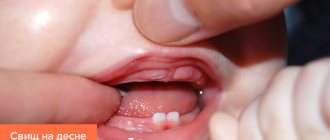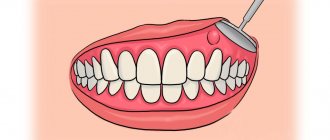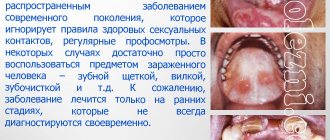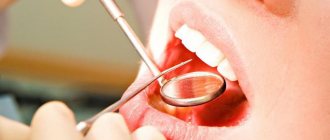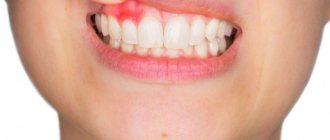What is flux
Flux is a somewhat outdated name that is common only in everyday communication. In modern dentistry, this pathology is called periostitis, which reflects the essence of the disease.
Periostitis is a purulent inflammation of the periosteum that covers the bone of the upper or lower jaw. As the pathological process develops, the lesion ceases to be local in nature and spreads to other tissues - an abscess appears on the surface of the gum.
Stages of inflammation development
The danger of flux lies in ignoring the initial symptoms. As a result, the doctor does not detect the problem in a timely manner. If at the initial stage the pathology is not accompanied by an increase in temperature, then after a few days the child is bothered by a strong fever. All 3 stages of development of the pathological process are described in detail in the table below.
| Stage of disease development | Short description |
| initial stage | At an early stage, flux is rarely accompanied by severe pain. It can only be recognized by the appearance of a small white bump on the gum. When contacting a dentist at this stage, the tooth can usually be saved. |
| Exacerbation period | If at the initial stage the symptoms of flux are left without proper attention, a period of exacerbation begins. On the gum, the ball increases in size, and its cavity is filled with purulent secretion. Treatment involves making a small incision in the gum, through which the surgeon removes the accumulated pus. He then treats the cavities with antiseptic solutions. Antibiotics are mandatory. The duration of their use is individual and determined by the doctor depending on the degree of damage. |
| Advanced stage | If treatment is not prescribed even after an exacerbation, the pathological process begins to spread deep into the tissues. Pus can even penetrate into organs. All this can lead to phlegmon, an extremely life-threatening condition. |
Correct determination of the stage of the disease allows you to select the most effective therapy. Initially, treatment is limited to symptomatic medications. At an advanced stage, surgery may be required.
Reasons for appearance
The appearance of such a disease in childhood is most often associated with the penetration of infection into the tissue, which provokes the development of a purulent process. There may be several reasons for this:
- Deep caries. It is known that baby teeth are less dense than permanent teeth, so the occurrence of even a minor carious defect can cause deep penetration of infection in the shortest possible time.
- Young children have a habit of tasting almost everything around them. This causes injury to the mucous membranes of the gums. And if pathogenic microorganisms get into such a wound, then due to the characteristics of the child’s body’s immune response, the likelihood of periostitis occurring is very high.
- It is quite difficult for children aged 2-4 years to carefully maintain oral hygiene and brush their teeth correctly. The accumulation of plaque and food particles in the gum pockets can cause inflammation with subsequent spread deep into the tissue.
- Sometimes flux appears after tooth extraction in the presence of a source of infection in the mouth: carious cavities, purulent gingivitis, sore throat. Pathogenic microorganisms easily penetrate deep into the gums through an open wound and, against the background of reduced immunity, cause severe inflammation.
- It is extremely rare, but periostitis can occur as a complication of purulent inflammation in a different location, when the infection enters the periosteum with blood.
Preventive actions
It is easier to prevent any problem than to treat it later. This statement is also true for flux, especially in childhood. There are certain preventive recommendations that will not be difficult for either the child or his parents to follow in everyday life. Moreover, they should become the norm. Only in this case can dental problems be avoided in the future.
- One of the main causes of gumboil, according to statistical data, is carious processes in the oral cavity. It does not play a special role what the problem was, whether it was neglected or simply undertreated. Regular visits to the dentist can help avoid it. It is recommended to visit the dentist every six months.
- It is important to maintain good oral hygiene. Teeth should be brushed twice a day using a properly selected toothbrush. Each age requires a certain stiffness and length of the bristles. It is also important to pay attention to toothpaste. At the same time, experts recommend choosing the most natural formulations.
- You should teach your child to rinse his mouth with plain water every time after eating.
- Once a year, professional hygienic cleaning of children's teeth is beneficial. Stone and plaque are an excellent environment for the life of pathogenic microflora.
- Diseased teeth must be treated promptly and, if urgently necessary, removed. This is much better than fearing the further spread of the infectious process to healthy areas.
- Solid foods must be present in a child's daily diet. First of all, we are talking about fruits and vegetables. For example, apples and carrots, which are inexpensive and accessible products, contain a lot of vitamins. At the same time, while chewing them, the teeth self-clean from accumulated plaque. The gums receive a good natural massage, and the osseous-ligamentous system improves.
Another important preventive measure that many parents forget about is regularly strengthening the immune system. It is important to maintain the protective forces of the child’s body at the proper level. Otherwise, they will not be able to resist basic infection.
Main symptoms and manifestations
In the first days of development of the inflammatory process, the child complains of moderate pain in the mouth. The gums at the site of inflammation swell slightly and become hyperemic. Children under 3 years of age may become capricious and refuse to eat. Most often, this stage of the disease goes unnoticed, and parents attribute its first manifestations to the child’s bad behavior.
As the purulent process develops, the child’s condition becomes more severe. The pain becomes intense and pulsating. A purulent focus forms on the gum in the form of a small whitish formation on a red, swollen background. Due to active inflammation, significant swelling of the soft tissues of the face develops. If flux appears on the upper jaw, then such swelling can be located not only on the cheek, but also spreads to the parotid region and the eye. If the flux is localized in the lower jaw, then tissue swelling may also affect the cervical region.
The baby’s general condition suffers and the temperature rises (sometimes to quite high numbers), the child complains of weakness and lack of appetite.
How to recognize flux in baby teeth in children
Among the main symptoms of the disease are:
- the appearance of an abscess on the gum at the base of the tooth crown;
- the occurrence of aching pain from the inflammatory reaction;
- pronounced swelling of the cheek;
- increased body temperature;
- general weakness, lethargy;
- the appearance of bad breath;
- enlargement of the lymph node located on the side of inflammation.
The flux makes the child feel unwell. He becomes capricious, whiny, and refuses to eat.
Possible complications
Very often, parents underestimate the seriousness of such a disease as gumboil in children. However, this pathology is fraught with extremely serious complications that can even threaten the baby’s life.
- An abscess is the formation of a large purulent focus, the boundaries of which extend beyond the periosteum. Sometimes such ulcers can break out in the gum or even cheek area, forming fistulas from which pus constantly flows.
- Cellulitis is the spread of purulent inflammation to adjacent anatomical areas. The most severe consequence of flux, in which there is a very high risk of developing sepsis - blood poisoning, often leading to death.
- Death of the rudiments of permanent teeth, leading to adentia. Severe inflammation within the gums can spread to the area of the permanent tooth bud and cause damage or death. As a result, when changing the primary dentition, the eruption of molars will not occur, which will require prosthetics at a young age.
It is not difficult to suspect the development of complications. Usually, with treatment after opening the flux, the symptoms quickly begin to subside. After a few hours, the child’s temperature decreases, swelling decreases, and the incision site practically does not hurt. But if the fever does not go away, and the pain only increases, then this is a reason to seek emergency medical help again, because Most likely there are inflammatory complications.
Diagnostics
Doctors are able to recognize periostitis in children based on a visual examination of the oral cavity. The disease occurs with pronounced symptoms, so there are no difficulties in making a diagnosis.
In some clinical cases, X-ray examination may be required to determine the extent of damage to teeth and soft tissues. If complications are suspected, laboratory diagnostics are prescribed - a general blood test. Based on the results, the most appropriate treatment regimen is selected.
Treatment
Treatment of flux in children should be carried out strictly under the supervision of a doctor. At the same time, treatment tactics for a one-year-old baby and a 7-year-old child may differ due to the fact that before the natural change of the primary bite, it is possible to remove a temporary tooth, which is extremely undesirable before the age of 5-6 years.
In such cases, it is rarely possible to do without surgery. Quite often it is necessary to resort to a surgical method of treatment - opening the flux with complete removal of all purulent masses and drainage of the resulting cavity. This allows you to both relieve acute pain and prevent the re-formation of gumboil.
But surgical treatment is one of the stages of therapy. After visiting the dentist, the child’s parents should continue treatment at home, which will include taking an antibiotic prescribed by a doctor, rinsing the mouth with antiseptic solutions and using traditional medicine.
Treatment at home
In the first few days after visiting the dentist, when pain may still bother the baby, it is necessary to take anti-inflammatory drugs (paracetamol, ibufen), which help both relieve pain and help the inflammatory process subside as quickly as possible.
An important point in home treatment is the use of antiseptic solutions for treating the oral cavity. The dentist will tell you what exactly to rinse the child’s mouth with, but we will only present possible treatment options that can be used even in a small child.
- Aqueous solution of chlorhexidine. A ready-made pharmaceutical preparation is used, which is used to rinse the mouth 3-4 times a day (after meals and before bedtime). It has a powerful antiseptic effect, but does not irritate the mucous membranes of the mouth.
- Furacillin solution. You can prepare it at home (1 tablet per 0.5 liters of water) or buy a ready-made product. Rinse your mouth up to 5 times a day (it is advisable to do this after eating).
- Miramistin is destructive to microorganisms and relieves inflammation well. It is recommended to rinse your mouth with 10 ml of solution 3-4 times a day. However, the drug cannot be used before the age of three.
A child should rinse his mouth with any of the above products strictly under the supervision of adults in order to avoid accidents. The course of treatment should continue until all manifestations completely subside and the purulent cavity heals.
Treatment with folk remedies
Traditional medicine recipes complement traditional treatment well. However, you need to be careful with such methods in very young children, and for treating children under 2 years of age it is better not to use them at all.
- Soda solution. This remedy has a good anti-inflammatory effect. A teaspoon of dry baking soda powder is dissolved in a large cup of warm boiled water and allowed to rinse the child’s mouth 3-4 times a day after eating. The effect of treatment can be enhanced with iodine by adding a few drops to the rinse solution.
- Propolis tincture also perfectly relieves inflammation and has an antiseptic effect. To treat the oral cavity, dissolve 5 drops of tincture in 200 ml of warm water and rinse the mouth 2-3 times a day.
- Herbal decoctions. Medicinal plants such as chamomile, calendula, and string are natural antiseptics and quickly relieve even severe inflammation. They allow both to cure the disease itself and to prevent the development of its complications. Decoctions are prepared daily, for which 2 tablespoons of a mixture of herbs are infused in half a liter of boiling water. Rinse your mouth with the resulting decoctions 4-5 times a day until complete recovery.
Homeopathy treatment
Homeopathic medicines can also be used in addition to primary treatment. You cannot try to cure gumboil in a child using homeopathy alone, since such remedies only play a supporting role. All prescriptions should be made only by a homeopathic doctor.
First aid for flux in a child
At the first symptoms of gumboil in a child, it is necessary to contact a pediatric dentist as soon as possible. However, if the journey takes some time, you can provide first aid to the child yourself.
- Anti-inflammatory drugs such as ibufen or paracetamol will help relieve acute pain, fever and reduce inflammation.
- In order to relieve swelling, you can give the child an antihistamine in an age-appropriate dose (for example, suprastin, parlazin).
- A cold compress applied to the area of inflammation will relieve pain and tissue swelling.
- It is strictly forbidden to try to open the abscess yourself. This can cause blood poisoning and further spread of the infection.
- If dental flux bursts on its own, under no circumstances should you try to squeeze out its purulent contents. This can cause severe complications.
It is strictly forbidden to heat flux or use Vishnevsky ointment, since such actions can intensify the inflammatory process and accelerate the development of complications.
»
Prevention
Flux, like any other childhood disease, is easier to prevent than to treat later. The famous doctor Komarovsky gives preference to the prevention of inflammatory diseases of the oral cavity from a very early age:
- Regular visits to the dentist's office for routine examinations and sanitation of even the smallest carious cavities.
- Complete treatment of all foci of infection in the child’s body.
- Parental control over the child’s compliance with high-quality oral hygiene.
- Fulfilling preventive doctor's prescriptions after tooth extraction.
Only compliance with such simple rules can guarantee reliable protection against both dental flux and other inflammatory diseases of the oral cavity.
Preventing the appearance of flux on the gums
Prevention of gumboil in children involves treating caries at an early stage, inflammatory gum diseases, as well as annual professional cleaning of baby teeth. Parents and the pediatric dentist should explain to the child the correct technique for brushing teeth and select individual oral care products for the little patient.
Bibliography
- Ivanova E.N. [and others] – Diseases of the oral mucosa – Rostov n/D.: Phoenix, 2007.
- Maksimovsky Yu.M. – Therapeutic dentistry, Textbook, M.: Medicine, 2002.
- Gaurav, Solanki and Renu Solanki - Dental Plaque Forming Bacteria's Characterization and Stress Responses - M.: LAP Lambert Academic Publishing, 2012.
- Ivanov V.S., Urbanovich L.I., Berezhnoy V.P. — Inflammation of the dental pulp, M., Medicine, 1990.
- Persin L.S., Elizarova V.M., Dyakova S.V. - Pediatric Dentistry, Medicine, 2006.
- Ralph E. McDonald, David R. Avery, Jeffrey A. Dean - Dentistry For The Child And Adolescent - Mosby - 2004
- Kuzmina E.M. et al. — Prevention of dental diseases in pregnant women and young children, M., MMSI. 1999.
Find a clinic
